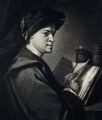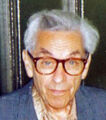|
|
| Line 1: |
Line 1: |
| <gallery> | | <gallery> |
| || *** DONE: Pics ***
| |
|
| |
| ||1484: William Caxton prints his translation of ''Aesop's Fables''. No DOB / DOD. Pic.
| |
|
| |
| ||1535: Georg Tannstetter dies ... mathematician, astronomer, and cartographer. No DOB. Pic.
| |
|
| |
| ||1656: Nicolaas Hartsoeker born ... mathematician and physicist. Pic: book cover.
| |
|
| |
| ||1698: Prokop Diviš born ... priest, scientist and inventor. In an attempt to prevent thunderstorms from occurring, he inadvertently constructed one of the first grounded lightning rods. Pic.
| |
|
| |
| ||1729: Simon de la Loubère dies ... mathematician, poet, and diplomat. Pic (book page).
| |
|
| |
| ||1729: Hugh Hamilton born ... mathematician, natural philosopher (scientist) and professor at Trinity College, Dublin, and later a Church of Ireland bishop, Bishop of Clonfert and Kilmacduagh, and then Bishop of Ossory. Pic.
| |
|
| |
| ||1753: Benjamin Thompson Rumford born ... physicist, government administrator, and a founder of the Royal Institution of Great Britain, London. Because he was a Redcoat officer and an English spy during the American revolution, he moved into exile in England. Through his investigations of heat he became one of the first scientists to declare that heat is a form of motion rather than a material substance, as was popularly believed until the mid-19th century. Among his numerous scientific contributions are the development of a calorimeter and a photometer. He invented a double boiler, a kitchen stove and a drip coffee pot. Pic.
| |
|
| |
|
| File:Nathaniel Bowditch.jpg|link=Nathaniel Bowditch (nonfiction)|1773: American captain and mathematician [[Nathaniel Bowditch (nonfiction)|Nathaniel Bowditch]] born. He will be a founder of modern maritime navigation; his book ''The New American Practical Navigator'', first published in 1802, will be carried on board every commissioned U.S. Naval vessel. | | File:Nathaniel Bowditch.jpg|link=Nathaniel Bowditch (nonfiction)|1773: American captain and mathematician [[Nathaniel Bowditch (nonfiction)|Nathaniel Bowditch]] born. He will be a founder of modern maritime navigation; his book ''The New American Practical Navigator'', first published in 1802, will be carried on board every commissioned U.S. Naval vessel. |
|
| |
| ||1789: Meteorologist William Charles Redfield born ... known for his observation of the directionality of winds in hurricanes (being among the first to propose that hurricanes are large circular vortexes (John Farrar had made similar observations six years earlier) ... He was the first president of the American Association for the Advancement of Science (1843). Pic.
| |
|
| |
|
| File:John Mudge.jpg|link=John Mudge (nonfiction)|1793: Physician and engineer [[John Mudge (nonfiction)|John Mudge]] dies. He was the first self-proclaimed civil engineer, and often regarded as the "father of civil engineering". | | File:John Mudge.jpg|link=John Mudge (nonfiction)|1793: Physician and engineer [[John Mudge (nonfiction)|John Mudge]] dies. He was the first self-proclaimed civil engineer, and often regarded as the "father of civil engineering". |
|
| |
| ||1797: James Hutton born ... geologist and physician. Pic.
| |
|
| |
| ||1804: Wolfgang von Kempelen dies ... author and inventor, known for his chess-playing "automaton" hoax The Turk and for his speaking machine. Pic.
| |
|
| |
| ||1812: A political cartoon in the Boston Gazette coins the term "gerrymander" to describe oddly shaped electoral districts designed to help incumbents win reelection.
| |
|
| |
| ||1817: Botanist Carl Wilhelm von Nägeli born (or March 27). He studied cell division and pollination but became known as the man who discouraged Gregor Mendel from further work on genetics. He rejected natural selection as a mechanism of evolution, favouring orthogenesis driven by a supposed "inner perfecting principle". Pic.
| |
|
| |
| ||1822: Theodor von Grotthuss dies ... chemist known for establishing the first theory of electrolysis in 1806 and formulating the first law of photochemistry in 1817. His theory of electrolysis is considered the first description of the so-called Grotthuss mechanism. Pic.
| |
|
| |
|
| File:George Chrystal.jpg|link=George Chrystal (nonfiction)|1851: Mathematician [[George Chrystal (nonfiction)|George Chrystal]] born. He will be awarded a Gold Medal from the Royal Society of London (confirmed shortly after his death) for his studies of [[Seiche (nonfiction)|seiches]] (wave patterns in large inland bodies of water). | | File:George Chrystal.jpg|link=George Chrystal (nonfiction)|1851: Mathematician [[George Chrystal (nonfiction)|George Chrystal]] born. He will be awarded a Gold Medal from the Royal Society of London (confirmed shortly after his death) for his studies of [[Seiche (nonfiction)|seiches]] (wave patterns in large inland bodies of water). |
|
| |
| ||1859: Adolf Hurwitz born ... mathematician and academic. Pic.
| |
|
| |
| ||1860: Antonio Maria Bordoni dies ... mathematician who did research on mathematical analysis, geometry, and mechanics. Pic.
| |
|
| |
| ||1875: Max Abraham born ... physicist and academic. Pic.
| |
|
| |
| ||1880: Forestry biologist and botanist Theodor Hartig dies. Hartig discovered and named sieve tube element cells, and described what is now known as the Hartig net, a network of fungal hyphae that penetrate feeder roots and surround epidermal cells. Pic.
| |
|
| |
| ||1884: Georges Imbert born ... chemical engineer and inventor. Pic search.
| |
|
| |
| ||1908: Theodore Motzkin born ... mathematician. Pic search.
| |
|
| |
| ||1910: Auguste Charlois dies ... astronomer. Pic search.
| |
|
| |
| ||1893: James Bryant Conant born ... chemist, academic, and diplomat, 1st United States Ambassador to West Germany. Pic.
| |
|
| |
| ||1903: Patrick du Val born ... mathematician, known for his work on algebraic geometry, differential geometry, and general relativity. The concept of Du Val singularity of an algebraic surface is named after him. Pic: http://www-history.mcs.st-and.ac.uk/Biographies/Du_Val.html
| |
|
| |
| ||1911: Bernard Katz born ... biophysicist, Nobel Prize laureate. Pic search.
| |
|
| |
|
| File:Paul Erdős.jpg|link=Paul Erdős (nonfiction)|1913: Mathematician and academic [[Paul Erdős (nonfiction)|Paul Erdős]] born. He will firmly believe mathematics to be a social activity, living an itinerant lifestyle with the sole purpose of writing mathematical papers with other mathematicians. | | File:Paul Erdős.jpg|link=Paul Erdős (nonfiction)|1913: Mathematician and academic [[Paul Erdős (nonfiction)|Paul Erdős]] born. He will firmly believe mathematics to be a social activity, living an itinerant lifestyle with the sole purpose of writing mathematical papers with other mathematicians. |
|
| |
|
| ||1914: Toru Kumon born ... mathematician, academic, educator. Pic search.
| |
|
| |
| ||1916: Christian B. Anfinsen born ... biochemist and academic, Nobel Prize laureate. Pic.
| |
|
| |
| ||1922: Oscar Sala born ... nuclear physicist and academic. He will be a leading figure in Brazilian scientific research. Pic search.
| |
|
| |
| ||1922: Guido Stampacchia born ... mathematician and academic ... known for his work on the theory of variational inequalities, the calculus of variation and the theory of elliptic partial differential equations. Pic.
| |
|
| |
| ||1932: Henry M. Leland dies ... machinist, inventor, engineer, automotive entrepreneur and founded of Cadillac and Lincoln. Pic.
| |
|
| |
| ||1933: József Kürschák dies ... mathematician noted for his work on trigonometry and for his creation of the theory of valuations. He proved that every valued field can be embedded into a complete valued field which is algebraically closed. Pic.
| |
|
| |
| ||1936: Michel André born ... mathematician, specializing in non-commutative algebra and its applications to topology. He is known for André–Quillen cohomology. Pic search.
| |
|
| |
| ||1938: Anthony James Leggett born ... physicist and academic, Nobel Prize laureate (alive Aug. 2018).
| |
|
| |
| ||1940: Astrophysicist Wilhelm Anderson dies. Anderson studied the physical structure of the stars. Pic.
| |
|
| |
| ||1953: Jonas Salk announced the successful test of his polio vaccine on a small group of adults and children (vaccination pictured). Pic.
| |
|
| |
| ||1958: The United States Army launches Explorer 3.
| |
|
| |
| ||1962: Rajeev Motwani born ... professor of Computer Science at Stanford University whose research focused on theoretical computer science. He will be awarded the Gödel Prize in 2001 for his work on the PCP theorem and its applications to hardness of approximation. Pic.
| |
|
| |
| ||Genocide in Bangladesh with the launch of Operation Searchlight. https://en.wikipedia.org/wiki/1971_Bangladesh_genocide
| |
|
| |
| ||1974: Edward Condon dies ... nuclear physicist, a pioneer in quantum mechanics, and a participant in the development of radar and nuclear weapons during World War II as part of the Manhattan Project. The Franck–Condon principle and the Slater–Condon rules are co-named after him. Pic.
| |
|
| |
| ||1975: The Biological Weapons Convention comes into force.
| |
|
| |
| ||1983: Anthony Frederick Blunt dies ... leading British art historian who in 1964, after being offered immunity from prosecution, confessed to having been a Soviet spy. Blunt had been a member of the Cambridge Five, a group of spies working for the Soviet Union from some time in the 1930s to at least the early 1950s. His confession, a closely held secret for many years, was revealed publicly by Prime Minister Margaret Thatcher in November 1979. Pic.
| |
|
| |
| ||1996: Electrical engineer David Packard dies ... co-founder, with William Hewlett, of Hewlett-Packard. Pic.
| |
|
| |
| ||2010: The ROKS ''Cheonan'' sinking: ''Cheonan'', a Pohang-class corvette of the Republic of Korea Navy, carrying 104 personnel, sank off the country's west coast near Baengnyeong Island in the Yellow Sea, killing 46 seamen. The cause of the sinking remains in dispute, although evidence points to North Korea. A South Korean-led official investigation carried out by a team of international experts from South Korea, the United States, the United Kingdom, Canada, Australia, and Sweden presented a summary of its investigation on 20 May 2010, concluding that the warship had been sunk by a North Korean torpedo fired by a midget submarine. The conclusions of the report resulted in significant controversy within South Korea. Following the sinking, South Korea imposed sanctions against North Korea, known as the May 24 measures. North Korea denied that it was responsible for the sinking. North Korea's further offer to aid an open investigation was disregarded. China dismissed the official scenario presented by South Korea and the United States as not credible. An investigation by the Russian Navy also did not concur with the report. The United Nations Security Council made a Presidential Statement condemning the attack but without identifying the attacker.
| |
|
| |
| ||2011: Paul Baran dies ... engineer who was a pioneer in the development of computer networks. He was one of the two independent inventors of packet switched computer networking, and went on to start several companies and develop other technologies that are an essential part of modern digital communication. Pic.
| |
|
| |
| ||2012: Thomas M. Cover dies ... information theorist and professor jointly in the Departments of Electrical Engineering and Statistics at Stanford University. He devoted almost his entire career to developing the relationship between information theory and statistics. Pic.
| |
|
| |
| ||2015: Friedrich L. Bauer dies ... mathematician, computer scientist, and academic. Pic.
| |
|
| |
| ||2020: Rolf Huisgen dies ... chemist and academic. Pic.
| |
|
| |
|
| </gallery> | | </gallery> |



